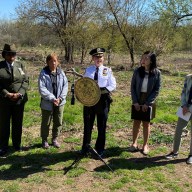By Betsy Scheinbart
Seven-year-old Destiny Kikeh is one of 35,000 children in Queens who has asthma, a chronic disease that causes ongoing swelling of the airways. She lives in Jamaica, the area of the borough with the highest rate of hospitalizations for children with asthma.
The cause of asthma is unknown, but there are many factors that are believed to cause asthma attacks, including exposure to allergens like dust, mold and pollen, tobacco smoke, and bad weather, according to the Jamaica Childhood Asthma initiative, an asthma advocacy and educational group.
During an asthma attack, the muscles surrounding the bronchial tubes, which carry air from the lungs, contract and airways become inflamed. Next mucus production increases, further clogging the tubes and making the lungs more susceptible to triggers, creating a vicious cycle.
Asthma tends to affect children more frequently and more severely than adults because a child’s airways are so small that even minor swelling severely impairs their breathing, said Dr. Phyllis Weiner, the chairwoman of pediatrics and the ambulatory care network at Jamaica Hospital.
The good news is that many children outgrow asthma as their lungs grow larger, Weiner said.
Weiner is among those who have speculated on a link between the borough’s two airports and the high instance of asthma in Queens.
“We know they are overcrowded and have too few runways, which means planes have to idle, and while they idle there are noxious emissions,” Weiner said.
Weiner said that those emissions could trigger asthma attacks for some people and affect the air quality, which has “a very heavy impact” on asthma.
State Assembly members William Scarborough (D-St. Albans) and Pauline Rhodd-Cummings (D-Far Rockaway) are sponsoring legislation that would require the Department of Environmental Conservation to study air emissions from areas surrounding Queens airports.
“Scientific research has shown that emissions of nitrogen oxides, carbon monoxide and VOCs from ground level ozone contribute to respiratory disease and the greenhouse effect,” Cummings said. “For example, a person living in an area with a high concentration of ozone smog has a greater chance of getting asthma.”
Lorna Davis, the director of health services at Safe Space, which runs the Jamaica Childhood Asthma Initiative, said South Jamaica — close to John F. Kennedy International Airport — has a high instance of hospitalizations from asthma attacks. Davis said she has speculated on the ties between the airport and asthma.
At least 35,000 Queens residents under 18 have asthma and the disease is most prevalent in southeast Queens, but the Jamaica Childhood Asthma Initiative reduced asthma sufferers’ visits to the emergency room by 50 percent, the Queens Borough Board said in its budget review March 7.
Weiner recommends that asthmatics use a peak flow meter to measure the quantity of air coming out of their lungs every day, so they can be aware in advance if an attack is coming.
“Asthma is a reversible disease and it can go away for a period of time, but people need to keep in touch with their symptoms on a daily basis,” Weiner said.
Destiny’s asthma is very unpredictable. Her doctors have been unable to pinpoint factors that cause her attacks.
She was diagnosed with asthma at three weeks old and was first hospitalized for the condition at three months old, said her mother, Abioseh Kikeh.
Destiny had been admitted to the hospital at least once a year and has been to the emergency room twice a year the past few years, her mother said.
Her asthma keeps her out of school about 20 to 25 days a year, but she is able to keep up with her studies anyway and is a good student in the first grade.
But Kikeh has trouble keeping a job because she misses work so often to take care of Destiny. The family often has to rely on welfare.
“I had to quit several jobs because of her condition,” Kikeh said. “It’s been hard, and it is hard for her, too. She can’t understand it.”
Kikeh said she recently quit her job when Destiny got very sick and needed to stay out of school for three days. A few months ago, she moved into a shelter with her three children.
According to the American Academy of Allergy, Asthma and Immunology, more than 17 million American have asthma. In 1999, 2,577 Queens children up to age 14 were hospitalized because of the disease, according to the New York City Department of Health.
There were 517 hospitalizations in Jamaica, a rate of 9.42 out of 1,000 children, compared to the overall rate of 7.12 in the borough, making Jamaica the neighborhood with the highest rate of hospitalization in the borough, according to the Health Department.
The Bronx had the highest hospitalization rate of all five boroughs, with 12.35 hospitalizations per 1,000 residents. Manhattan was the second-highest with a rate of 9.57, followed by Brooklyn at 7.82, just higher than the Queens total of 7.12. Staten Island had the lowest rate, with 3.73.
Laudrey Lamadieu, the initiative’s project director, said many families in Jamaica area have identified problems with their housing which contribute to their children’s asthma, including leaky faucets and pipes that cause mold and holes in the walls that allow pests like cockroaches or rodents to infest the building. All of these factors can trigger asthma attacks.
Gov. George Pataki launched a campaign earlier this month to promote asthma awareness and management. The state Department of Health has produced a series of television ads and created a web site at www.noattcks.org to raise awareness of childhood asthma.
Reach reporter Betsy Scheinbart by e-mail at Timesledgr@aol.com or call 229-0300 Ext. 138.





























